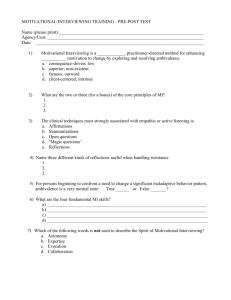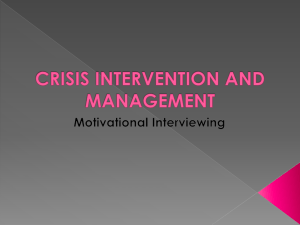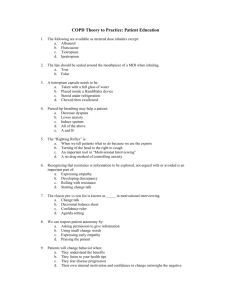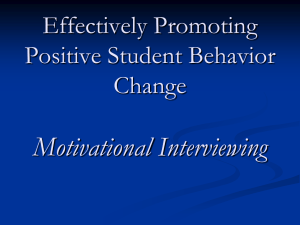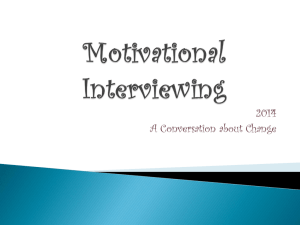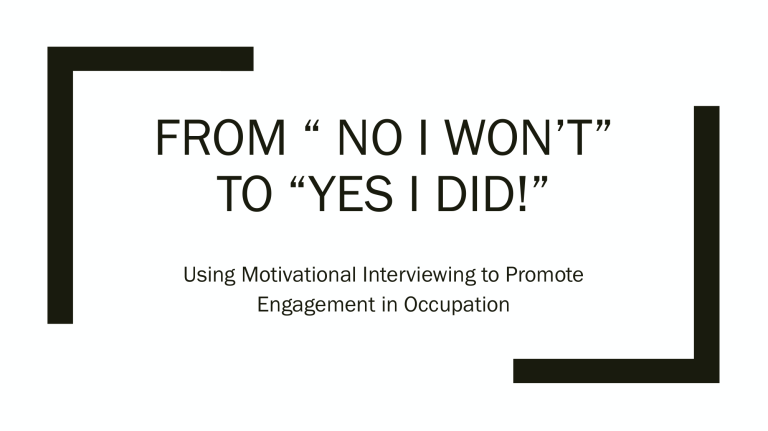
FROM “ NO I WON’T” TO “YES I DID!” Using Motivational Interviewing to Promote Engagement in Occupation Objectives ■ Participants will define motivational interviewing (MI). ■ Participants will relate the use of MI to the practice of occupational therapy (OT), including core values and practices, and relation to occupation. ■ Participants will identify populations that may benefit from the use of MI in OT. ■ Participants will demonstrate the four core skills of MI. Population/Setting and OT Focus ■ Chronic pain, return to work ■ Hand therapy, home program ■ Diabetes, healthy cooking ■ Spinal cord injury, pressure relief ■ Fall risk, remove clutter ■ Hypertension, medication management ■ Post-stroke, stress management ■ Parents of children with disabilities, use of assistive tech WHAT DO THESE SCENARIOS HAVE IN COMMON? Discussion ■ Question 1: What barriers does your population likely encounter that limits performance of the identified occupation? ■ Question 2: Considering these barriers, if someone told a client how to improve in this area, what might the client say in response? ■ Chronic pain, return to work ■ Hand therapy, home program ■ Diabetes, healthy cooking ■ Spinal cord injury, pressure relief ■ Fall risk, remove clutter ■ Hypertension, medication management ■ Post-stroke, stress management ■ Parents of children with disabilities, use of assistive tech Imagine that your client says… ■ … “I want to go back to work, but I’m not sure how to manage the pain and get my work done.” ■ … “All of you therapists come in here and tell me to clean my house. It’s cleaner than it’s ever been! I just need to be more careful when I walk.” ■ … “It’s time for me to cook my own meals. Eating out is expensive, and it’s not good for my health.” Learn to cook Return to work Move newspapers Where do you want YOUR client to be? Question 3 ■ Relate the client quotes from Question 2 to these steps/stages. ■ Where is your imagined client right now? HOW CAN YOU HELP THEM GET TO “YES I DID”? Client Interactions How Would You Respond? ■ … “I want to go back to work, but I’m not sure how to manage the pain and get my work done.” ■ … “All of you therapists come in here and tell me to clean my house. It’s cleaner than it’s ever been! I just need to be more careful when I walk.” ■ … “It’s time for me to cook my own meals. Eating out is expensive, and it’s not good for my health.” “Traditional approaches to treating individuals …might include educating them about their condition, giving recommendations on how to prevent and recover from the injury, and instructing them on home exercises and activity modifications. With my client, these approaches initially led to resistance and little compliance.” (Bracken, 2017, p. 20) Ambivalence and Influencing Change Make a Change Stay the Same Stages of Change (Prochaska & DiClemente, 1984) Precontempation “I won’t do it.” "I can't do it." Contemplation "I want to do it." "How do I do it?" Preparation "I'll try to do it." "I can do it." "I will do it." Action "I'm doing it!" Maintenance "Yes, I did it!" "I'm still doing it!" Motivation ■ Movement toward change ■ Occurs when ambivalence is resolved ■ Results from interactions – Does NOT reside within clients (Miller & Rollnick, 2012) Motivational Interviewing (MI) “Motivational interviewing (MI) is a collaborative, goal-oriented style of communication…designed to strengthen personal motivation for and commitment to a specific goal by eliciting the person’s reasons for change within an atmosphere of acceptance and compassion.” (Miller & Rollnick, 2012, p. 29) Motivational Interviewing (MI) In other words... A way to talk with people about change. MI’s Relationship to OT ■ Therapeutic use of self ■ OT’s values – Client-centered – Considers client’s contexts; values and beliefs; personal goals ■ Motivation affects participation and occupational performance By U.S. Navy photo by Mass Communication Specialist 3rd Class Jake Berenguer [Public domain], via Wikimedia Commons WHAT SPECIFIC SKILLS DOES MI INVOLVE? Core Skills of MI ■Open-Ended Questions ■Affirmations ■Reflections ■Summaries Open-Ended Questions ■Get more information ■Avoid assumptions ■Provide clarification ■Not inquisition Affirmations ■Client strengths ■Genuine statements ■“You” ■Choose specific behaviors Reflections ■ Check your understanding ■ Processing time ■ Capture positives ■ Reinforce change talk ■ Reflections as statements – Avoid “It sounds like…” – Don’t ask questions ■ Incorrect reflections are OK! Summaries ■ Use “and”, avoid “but” ■ Clarification ■ Change talk ■ Be concise ■ Change the path Back to Occupation… Some Possible Responses Client Says… The OT Might Say… ■ “I want to go back to work, but I’m not sure how to manage the pain and get my work done.” ■ “Getting back to work and doing your job well is really important to you.” ■ All of you therapists come in here and tell me to clean my house. It’s cleaner than it’s ever been! I just need to be more careful when I walk.” ■ “You’ve worked hard to pick things up so that you don’t trip, so it’s frustrating to be told that you should do more cleaning. It seems like there must be a different approach to keep you safe.” ■ “It’s time for me to cook my own meals. Eating out is expensive, and it’s not good for my health.” ■ “What steps do you think you might take to begin cooking meals for yourself?” Supporting Evidence Return to work with chronic pain: Thompson, 2013 Healthy cooking with diabetes: Mann, Javaherian-Dysinger, & Hewitt, 2013 Social participation with Vets with PTSD: Beauchesne & Jacques, 2015 Instead of this… ■ Occupation-Based? ■ Client-Centered? ■ Self-Motivated? ….Let’s aim for this… “Your purpose is to understand the life before you, to see the world through this person’s eyes rather than superimposing your vision.” (Miller & Rollnick, 2012, p. 16) References ■ Beauchesne, J. & Jacques, C. (2015). From combat to compassion: Enabling change in Veterans. Occupational Therapy Now, 17(5), 26. ■ Blanche, E. I., Fogelberg, D., Diaz, J., Carlson, M., & Clark, F. (2011). Manualization of occupational therapy interventions: Illustrations from the pressure ulcer prevention research program. American Journal of Occupational Therapy, 65, 711719. ■ Bracken, A. (2017, May 8). Engaging challenging clients through Motivational Interviewing. OT Practice, 20-22. ■ Hildebrand, M. (2015). Effectiveness of interventions for adults with psychological or emotional impairment after stroke: An evidence-based review. American Journal of Occupational Therapy, 69(1), 1-8. References ■ Mann, D. P., Javaherian-Dysinger, H., & Hewitt, L. (2013, September 23). Ounce of prevention: Using the power of lifestyle to improve health outcomes. OT Practice, 16-21. ■ Miller, W. R., & Rollnick, S. (2012). Motivational interviewing: Helping people change (3rd ed.). New York, NY: Guilford Press. ■ Schwartz, J. K., Grogan, K. A., Mutch, M. J., Nowicki, E. B., Seidel, E. A., Woelfel, S. A., & Smith. R. O. (2017). Intervention to improve medication management: Qualitative outcomes from a Phase I randomized controlled trial. American Journal of Occupational Therapy, 71(6), 1-10. ■ Thompson, B. (2013). Are you ready? Readiness to return to work for people living with chronic pain. Occupational Therapy Now, 14(5), 13-15. Questions?
